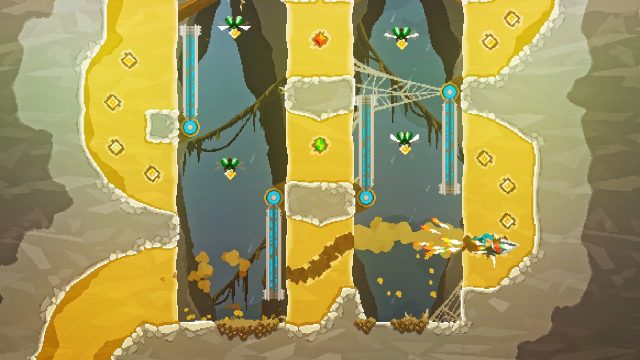Charming aesthetic; strong retro sensibilities paired with unusual and demanding mechanics
Bosses are awkward; collectibles and other incentives are underwhelming; controls feel finicky in handheld mode
At first blush, Pepper Grinder is cute and colorful and retro. It’s a specific flavor of cute (small child with a giant drill) that can’t help but bring to mind both Game Freak’s 2005 Drill Dozer and Namco’s long-running Mr Driller series. On closer inspection, while the game is in fact cute and colorful and retro, Pepper Grinder doesn’t have anything in common with the brick-by-brick approach of the latter or the cozy stop-and-go feeling of the former. Instead, it is a surprisingly fast-paced platformer which is first and foremost about momentum and forward movement. The dev’s influences include 16-bit classics with an emphasis on one or both, like the Sonic games, those frequent segments of Donkey Kong Country involving barrels and minecarts, and Ecco the Dolphin. These retro influences are clear enough from the game itself, but publisher Devolver Digital’s page for the game even includes a faux Super Nintendo instruction manual, which is recommended reading. Seriously, the manual will clue you in on some mechanics that aren’t explained by the game itself, as was the norm before tutorials became ubiquitous.
When Pepper (the girl) spins up Grinder (the drill), it becomes a melee weapon that can damage enemies or objects in the environment, but its true strength only becomes clear when she aims it to make contact with dirt or other soft surfaces. When that happens, Pepper’s movement speed increases drastically and she can steer the drill in any direction. The most critical thing to understand about Pepper Grinder is that once the drill hits the dirt, it cannot stop spinning and Pepper cannot stop moving until she emerges from the dirt. Early on, emerging may put Pepper back on terra firma. As the game ramps up, however, the only thing between one patch of dirt and the next will often be just sky, and Pepper will arc through it like Ecco did in 1992, unable to adjust her arc, feverishly praying that she exited the first patch of dirt at the correct angle. You can’t stop cold when submerged. Contra Sonic the Hedgehog, “gotta go fast” is here not merely a catchphrase but a technical requirement. Best you can do is make tight, speedy circles over and over while you wait for the right opportunity or prepare to line up your next move.
Angles matter a lot in Pepper Grinder, and precision is important in order to have a fluid, satisfying time with these stages and especially with the boss fights. Get the angle wrong slightly and you may careen into a pit or a bramble or just a hard rock wall. In this way the game also brings to mind Meat Boy/Celeste-style precision platformers, requiring the player to chain a series of precise movements one into another without room to breathe between, before reaching the next checkpoint. Celeste’s famous game speed toggle/accessibility feature turns up in the options as well. The manual dexterity required to clear Pepper Grinder is not at the same level as Meat Boy or Celeste, but nevertheless it’s important to keep in mind that Pepper Grinder is not a particularly mellow game and is going to be best appreciated by those who not only like a challenge but enjoy pushing themselves.
Pepper Grinder’s campaign is relatively brief (16 stages of ~3-5 minutes each, with a few more unlockable stages, plus 4 bosses). A player who’s not interested in doing more than reaching the credits and putting Pepper Grinder back on the shelf may or may not get their money’s worth. The campaign, and its KONG letter-style Skull Coin collectibles, seem like they’re designed to get the player accustomed to both the mechanics and stages, in order to entice them into digging into the game’s most satisfying content — Time Attack mode. By the time the player has found all the Skull Coins, they’ve learned each stage enough to actually play them fluidly, and Time Attack provides at least some incentive to do so.
The rewards for Time Attack are just sprite stickers that you can compose into your own postcard dioramas, so hopefully either that sounds delightful or you just don’t need much extrinsic motivation. Either way, the game’s controls do have a bit of a learning curve and that’s an awkward fit for the game’s short length if you don’t count the Time Attack stage replays. To anyone who does pick up Pepper Grinder, I strongly recommend engaging with Time Attack to make the most of it, even if that’s not normally your cup of tea. Without it, Pepper Grinder can feel like half a game. Tellingly, the main campaign — everything other than Time Attack — is labeled Casual Play, so if you mean to take the game at all seriously expect to count the seconds.
The bosses are the most mechanically unsatisfying parts of the game, without exception. They’re visually charming, but the slightly unpredictable/wild angles of Pepper’s tunnels and jump arcs introduces a little too much chaos into these fights. The player earns gobs of money as they move through the regular stages and can easily buy extra “armor” (temporary bonus HP) from shopkeepers to tank through what can feel like cheap shots, but even though I was evangelizing Time Attack mode one paragraph ago, none of the bosses felt satisfying enough to bother revisiting in any capacity.
Visuals and audio are both on point throughout. The artwork finds a nice sweet spot between legibility, simplicity, and personality, and the music is solid too. Just the title screen makes a heck of an impression on both counts — seriously, check it out on YouTube if you do nothing else with the information in this review. As far as I can tell this is the first commercial release for both developer Arh Ech and composer Xeecee, and it’s a strong debut.
One important caveat, since this review is for the Switch version of the game: at least in handheld mode, the analog stick precision doesn’t feel reliable enough for the game’s speed and level design. With its minimalist but charmingly expressive spritework and its bright colors, Pepper Grinder looks like a handheld “play in bed” sort of game, and it’s really not. I played Pepper Grinder in its entirety on my Switch Lite, but would recommend playing docked with a Pro Controller. Sure, the Celeste-style slowdown option means that you can make it work, but who wants to race through a stage in slow motion?
Despite the small scope and some imprecise and chaotic aspects, Pepper Grinder is worth picking up for platforming fans looking for something that manages to be both novel and challenging, and its considerable audiovisual charm absolutely doesn’t hurt.
Nintendojo was provided a copy of this game for review by a third party, though that does not affect our recommendation. For every review, Nintendojo uses a standard criteria.




 ShareThis
ShareThis







